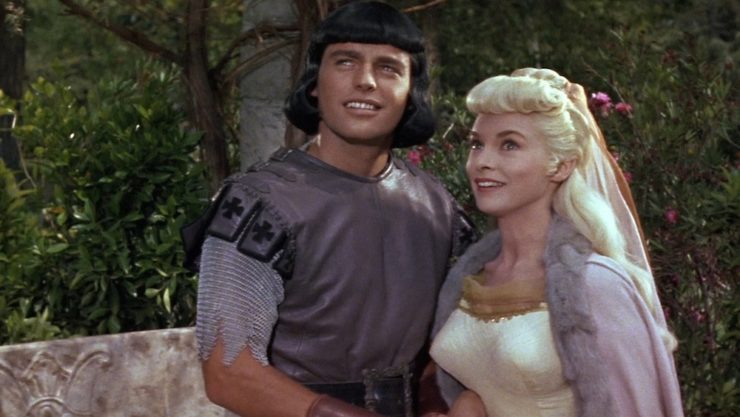Prince Valiant by the great Hal Foster debuted in 1937 as a comic strip. Taking place during the mythical, fictional reign of King Arthur, the strip has chronicled the life of its title character from when he was a boy through to adulthood as a member of the Knights of the Round Table. Eighty-two years later, forty-eight years after Foster’s retirement from the strip due to arthritis, and thirty-seven years after Foster’s death, the strip is still going strong, still appearing weekly in three hundred newspapers. It’s currently written by Mark Schultz and illustrated by Thomas Yeates.
Twice, the strip has been adapted to live-action film, once in the 1950s, and again in the 1990s.
Valiant was nontraditional, in that instead of using word balloons, the story is told via illustrations and narrative captions on the sides, in the margins, and in other emptier spaces. It also followed its hero from when he was five years old, working his way toward becoming one of Arthur’s knights.
Foster came to prominence thanks to his magnificent visuals on the Tarzan strip, and he pitched Prince Valiant to William Randolph Hearst, a longtime fan of Foster’s who was so impressed with the work that he uncharacteristically allowed Foster to retain ownership of the strip in order to be able to syndicate it to his newspapers.
The strip started out with lots of fantasy elements, with Valiant facing monsters and such as well as the presence of Merlin and Morgan Le Fay, both wizards, though those elements were lessened as time went on. The strip has always taken a very free-wheeling approach to history, following the same “it all happened in the before-time” philosophy that would later mark Hercules: The Legendary Journeys and Xena: Warrior Princess, with elements from the nominal fifth-century setting mixed in with stuff from the Middle Ages and the tenth century and so on…
MGM had obtained the rights to the strip in the 1940s, but never produced a film, overwhelmed as they were by the sprawling nature of the strip’s storyline, and the option lapsed. 20th Century Fox snatched it up in 1952 at the urging of studio head Darryl F. Zanuck’s son-in-law Robert L. Jacks, who produced the film, which was released in 1954. It had a huge budget for the time, almost $3 million, and was one of the earliest movies filmed in the then-cutting-edge CinemaScope. Robert Wagner starred in the title role, along with Janet Leigh, James Mason, Debra Paget, Sterling Hayden, Victor McLaglen, Donald Crisp, Primo Carnera, and Brian Aherne. The movie, unfortunately, did not recoup its tremendous production costs, and a planned sequel, Valiant and Aleta, was never made.
In the 1990s, a bunch of independent European production companies got together to take another shot at a Valiant film, with Stephen Moyer in the title role, starring with Katherine Heigl, Ron Perlman (previously seen in this rewatch in Hellboy, Hellboy II: The Golden Army, and Blade II), Thomas Kretschmann (previously seen in this rewatch in Captain America: The Winter Soldier, Avengers: Age of Ultron, and also Blade II), Edward Fox, Udo Kier (previously seen in this rewatch in Barb Wire and Blade), Warwick Davis, Walter Gotell (in, sadly, his last role before he died the year the film was released), and the great Joanna Lumley, as well as director Anthony Hickox, casting himself as Sir Gawain.
The producers reportedly had issues with Hickox’s cut of the film (as did some of the actors), and the production company re-cut the film without his input. The film itself had a scattershot release in theatres in Europe and did very poorly, and the multiple small film companies involved in putting it out has made home video distribution a bit messy, with the result that it’s damn near impossible to find in the U.S. now.
“Do you think I’ll die quietly?”
Prince Valiant
Written by Dudley Nichols
Directed by Henry Hathaway
Produced by Robert L. Jacks
Original release date: April 2, 1954
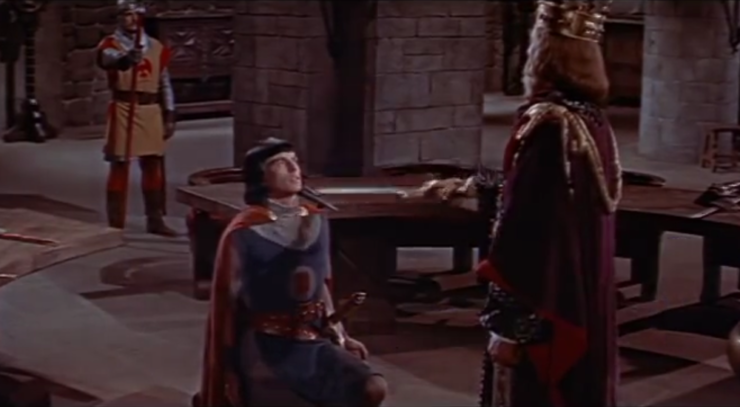
The king of the Vikings, King Aguar, and his wife and son, are forced into exile by Sligon the Usurper. Aguar’s son, Prince Valiant, is sent to Camelot to train under King Arthur’s knights. En route, he encounters Sligon’s Vikings meeting with a knight in black armor. Valiant manages to escape the knight and the Vikings, then comes across another knight, whom he mistakenly thinks is in league with them, and knocks the knight off his horse.
This turns out to be Sir Gawain. Valiant apologizes for knocking him on his ass and accompanies Gawain back to Camelot to tell King Arthur of this mysterious black knight. Valiant asks to be made a knight, but is indulgently told by Arthur and Sir Brack that he has to earn his way to the knighthood. Brack asks to take on Valiant as a squire, but he is instead assigned to Gawain.
In the midst of Valiant’s training, Brack informs him that he’s off to track the black knight. Valiant impulsively goes with him, abandoning his training. They are separated, and then Valiant is ambushed by Vikings. He manages to get away, but they shoot him in the shoulder with an arrow as he retreats. Wounded, he collapses on his horse, which wanders into the kingdom of King Luke, who takes the wounded squire in. As he recovers, Valiant falls in love with Luke’s daughter, Aleta. Luke’s other daughter, Ilene, secretly loves Sir Gawain.
Once Valiant has recovered, Sir Brack insists they return to Camelot. A tournament is to be held in honor of King Luke’s daughters. When they return, Valiant discovers that Gawain has also been wounded by the black knight. Gawain went after Valiant, not knowing he went with Brack, and encountered the renegade knight.
While he recovers, Gawain meets both Aleta and Ilene, and falls in love with Aleta while mistakenly thinking that Valiant loves Ilene.
King Arthur announces that the winner of the tournament will have Aleta’s hand in marriage. Sir Brack cleans up at the tournament, but then another challenger arrives, dressed in Gawain’s armor. Everyone assumes it’s Gawain, but it is, in fact, Valiant, whom Brack defeats. Then another armored challenger arrives who defeats Brack—it’s Gawain, but he collapses from his wounds.
For posing as a knight, Valiant is to be imprisoned, though Brack argues to let him be confined to his quarters rather than put into a dungeon, for as the son of a Viking he didn’t know any better, and was only trying to help his patron.
Brack then meets with a mysterious stranger, who hands him King Aguar’s signet ring. Brack throws it through Valiant’s window, and the prince immediately leaves to go after his father, whom he thinks is in trouble.
And he’s right about that. He’s ambushed by Sligon’s Vikings and the black knight, who turns out to be Brack. The renegade knight has allied with Sligon, and will use the Vikings as his personal army to conquer Arthur.
Aleta, who refuses to marry Gawain because she loves Valiant, chased after him, and she too is captured by Sligon’s forces. They are both brought to Sligon’s castle and interrogated and imprisoned. Valiant manages to escape his cell just as a group of Christian Vikings attack Sligon’s castle. Valiant sets fire to Sligon’s castle and defeats Sligon in single combat.
Freeing his parents and beloved, he returns to Camelot to accuse Brack of treachery. Brack responds by demanding trial by combat. Valiant defeats him after a lengthy swordfight. Gawain—who offered to fight in Valiant’s stead against Brack—reveals that he and Ilene fell in love while worrying about the captured Valiant and Aleta, thus leaving Valiant—now a Knight of the Round Table—free to marry Aleta.
“One should never leave drugs lying around…”
Prince Valiant
Written by Michael Frost Beckner and Anthony Hickox & Carsten Lorenz
Directed by Anthony Hickox
Produced by Tom Rosenberg and James Gorman and Bernd Eichinger
Original release date: December 19, 1997
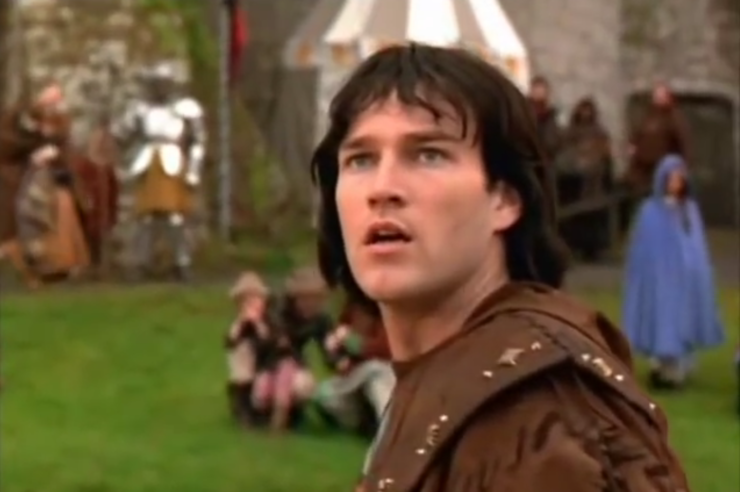
A group of Vikings loyal to Sligon unearth Merlin’s corpse on behalf of Morgan Le Fay. They remove his spellbook (which is conveniently labelled, “MERLIN”). A band of them, led by Sligon’s brother Thagnar, sneak into Camelot while the annual jousting tournament is going on and steal Excalibur, killing one of Arthur’s knights.
Oblivious to all this, the tournament goes on, observed by Princess Ilene. Prince Arn, Ilene’s fiancé, defeats Sir Gawain. Gawain’s squire, Valiant, switches armor with his patron and then asks for a rematch pretending to be Gawain. He breaks Arn’s nose after telling him his fly is open (seriously), but then the fight is cut short by the death screams of the knight guarding Excalibur.
By the time Arthur and the others arrive, the knight is dead, Excalibur is gone, and a tartan has been left behind on the corpse. Arthur and the Knights of the Round Table all assume that Scotland invaded, and Arthur’s knights gather their forces. Arn leads those forces north.
Ilene visits Gawain’s quarters to talk to the knight who fought so valiantly (ahem), and Valiant pretends to be Gawain while hiding under his bed’s canopy (Gawain himself is still unconscious). Arthur then summons Gawain, and discovers that Valiant has been disguising himself as him. The king asks him to maintain the deception a bit longer, as a knight must escort Ilene back home to Wales.
En route, they’re ambushed by Vikings and Ilene is kidnapped. Valiant is able to rescue her from the Viking leader, Boltar, who recognizes the red lion-head emblem Valiant wears around his neck. For his part, Valiant knows only that he was wearing it when his parents left him as an infant at a monastery, where he was raised until he became Gawain’s squire.
Sligon enjoys wielding Excalibur at first, but its power becomes too much for him, and he loses his grip on it. It embeds in the stone ground, and nobody can remove it—except for a true king. Sligon refuses to, and no one else can. Morgan has a vision that the sword can be removed by Gawain—but unbeknownst to her, the vision she saw was of Valiant disguised in Gawain’s armor.
Back in Camelot, Gawain, only semi-recovered, rides after Valiant, as Ilene is late arriving in Wales, and Gawain is worried.
Valiant and Ilene flirt while he checks her injured leg, and then they are greeted by one of Ilene’s father’s men—but that soldier is dead, being held up on his horse by a Viking. They’re ambushed by Thagnar and his people, who claim to have Excalibur. Gawain arrives in the nick of time to fight on their behalf, but he’s captured. Both Valiant and Ilene manage to escape by swimming downriver—Valiant fell into the river and Ilene dove after him—and then are rescued by Ilene’s father King Thane.
Realizing that Thagnar has Excalibur, not the Scots, Valiant rides north to convince Arn that he’s fighting the wrong people. Ilene gives him her ring to prove to Arn that he’s telling the truth. When Valiant arrives, Arn refuses to believe him, thinking him a Scottish spy who has Ilene imprisoned, as she would never take the ring off. (Poor bastard.) He challenges Valiant to a duel, and they fight for about half an hour, with Valiant constantly disarming Arn and Arn re-arming himself. When Valiant finally wins, Arn says to finish him, but Valiant says he’s here for his help not his blood, at which point Arn starts to possibly believe him.
The two of them go to Thagnar’s camp. Why just two of them go to rescue Gawain when they’ve got a whole army is left as an exercise for the viewer. They sneak in to rescue Gawain at the same time that Ilene, wearing borrowed armor, does likewise. The four of them were too loud even for the Vikings, apparently, as they’re attacked. Arn is killed, Gawain and Ilene captured, and Valiant tossed into the river this time by Thagnar.
Gawain is brought to Excalibur, but when he can’t remove it from the stone, either, Thagnar kills him, and Morgan is pissed, because her visions never lie. Ilene is made part of Sligon’s harem.
Valiant washes up on the south shore of England and goes to a tavern, where he defends the honor of a person of tiny stature. Said person, Pechet, declares his loyalty to Valiant. Also in the tavern is Boltar. Valiant isn’t thrilled to see him, but he can get Valiant to Thule for a few gold coins—which Pechet provides off the unconscious body of the guy Valiant knocked out on his behalf.
Upon arriving in Thule, Boltar reveals who Valiant is: the son of King Aguar, the rightful king of the Vikings, who was overthrown by Sligon. While the usurper killed the rest of the royal family, Valiant was spirited away to England.
Valiant sneaks into Sligon’s castle to make sure Ilene and Gawain are safe before Boltar’s forces attack. Unfortunately, he’s captured, and he and Ilene put in a James Bond-style death trap for some inexplicable reason, hanging over armored alligators while a candle burns through the rope holding them up. They’re rescued by Pechet, whom Boltar sent in via catapult, which somehow didn’t kill him, and then Boltar’s forces attack.
By this time, Thagnar has killed Sligon and claimed Excalibur for himself. Morgan tries to use mesmerizing dust on Ilene, but she sneezes it back on her (really!), and she falls into a vat full of gunk that kills her. Valiant faces Thagnar, and they duel until Valiant finally defeats him.
Back in Camelot, Arthur is about ready to abdicate because he doesn’t have his sword, but then Valiant rides in and presents Excalibur to him, identifying himself as the rightful ruler of Thule. Arthur knights him, and they all live happily ever after.
“He told them I was valiant, and that became my name”
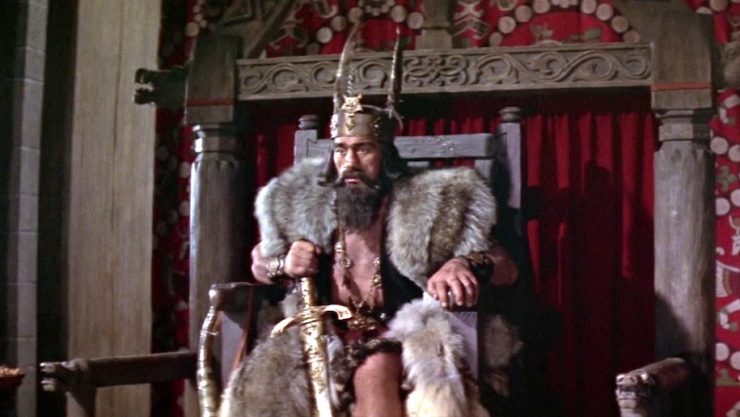
Before we dive into the review, I just want to say how much of a kick I got out of seeing Primo Carnera as Sligon in the 1954 movie, though his thick Italian accent required him to be dubbed. Carnera was the heavyweight champion of the world in the 1930s, and after he retired due to his diabetes, he had a career as an actor in Italy and elsewhere, appearing in films ranging from Mighty Joe Young to Hercules Unchained.
I only mention all this because Carnera is from Sequals, Italy, a small town about two hours north of Venice, and also the hometown of my father’s side of the family. Carnera and my paternal grandfather, Gildo DeCandido, were actually very close friends. They were an amusing pair, as Carnera was 6’6” and my grandfather was a full foot shorter. Nonno was also deaf in one ear, nearsighted, and had flat feet. (He was drafted for World War II in late 1944. As he himself said, “By the time they got to me, they’d already scraped the bottom of the barrel, and now they had picked up the barrel and were grabbing what was under it.”)
One time, in the late 1930s, Carnera went on tour, and he invited my grandfather along. The problem was that, for the paperwork, Carnera had to give Nonno a specific job, and pretty much all the possible jobs were taken—but then Carnera had a brainstorm. And so my grandfather—5’6”, deaf in one ear, nearsighted, flat feet—was heavyweight champion of the world Primo Carnera’s bodyguard.
I’m telling you that story, because it’s more fun than writing about these two lifeless husks. Prince Valiant is a unique, lush, beautiful comic. Hal Foster’s bold line-work and beautiful landscapes and detailed character work is some of the finest we’ve ever seen. He could draw a regal castle or a ship at sea—but also nobody was better at illustrating two people in a room confronting each other.
Neither of these adaptations are able to capture Foster’s style. The 1954 film tries its best, using second-unit location shooting instead of stock footage in an attempt to look more realistic, and using the bold angles and colors of CinemaScope. Sadly, it’s done in by a flat performance by Robert Wagner in a silly wig as the titular hero, and an even more ridiculous performance by Sterling Hayden, whose Gawain sounds like he’s from the south side of Chicago. The movie feels like the comic strip, moving from set piece to set piece, but with a distressing lack of urgency.
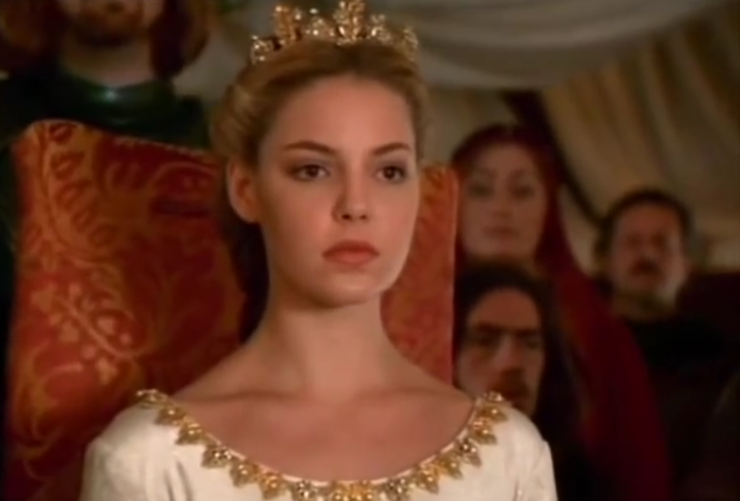
The 1997 film doesn’t have that problem, but it’s okay, because it has every other problem. It’s too bad, because Stephen Moyer would have made a good Valiant in a proper adaptation—he has the earnestness and the charisma—but he’s saddled with Anthony Hickox going for goofy slapstick over serious drama, from Valiant telling Arn his fly is down during the joust to Ilene sneezing back Morgan’s pixie dust with a shrug and a modestly uttered, “Hay fever!” (Allegedly the original cut was even worse in this regard before the production company edited it without Hickox’s involvement.)
There’s no attempt at the grandeur of the comic strip here, instead doing a low-rent riff on all the low-budget absurdist fantasy movies that choked the cinematic landscape in the 1980s. It’s not silly enough to be fun, and it’s not serious enough to be thrilling. Katherine Heigl has only one bullet in her gun—pretty, pouty, haughty person—and she fires it repeatedly here.
The fight and stunt choreography in this movie could charitably be called poor. People are wounded by swords that glance by with the flat of the blade, the movements are awkward and clunky, and it’s just horrible. The 1954 film, at least, makes an effort at making those parts fun. The climactic swordfight between Valiant and Brack in the 1954 film is thrilling; the like swordfight between Valiant and Thagnar in the 1997 film is a mess.
Neither of these adaptations are worthy interpretations of one of the most visually stunning comic strips of all time, and it’s a damn shame. There are some fine actors here—nobody ever went wrong casting James Mason or Joanna Lumley, and Ron Perlman, as always, gives his best no matter what dreck he’s in—but both movies fail on multiple levels.
Next week, another 1930s comic strip icon brought twice to the screen, as we look at the 1980 and 2007 attempts at a live-action Flash Gordon.
Keith R.A. DeCandido is an author guest at Tampa Bay Comic-Con this weekend at the Tampa Convention Center. He’ll be spending most of his time at Bard’s Tower, Booth 1435, selling and signing books, including his brand-spanking-new release, Alien: Isolation. Accompanying him at the Tower will be fellow scribes Peter David, Melinda M. Snodgrass, Jason Fry, Dan Wells, Carlos Ferro, T. Allen Diaz, and Megan Mackie.










